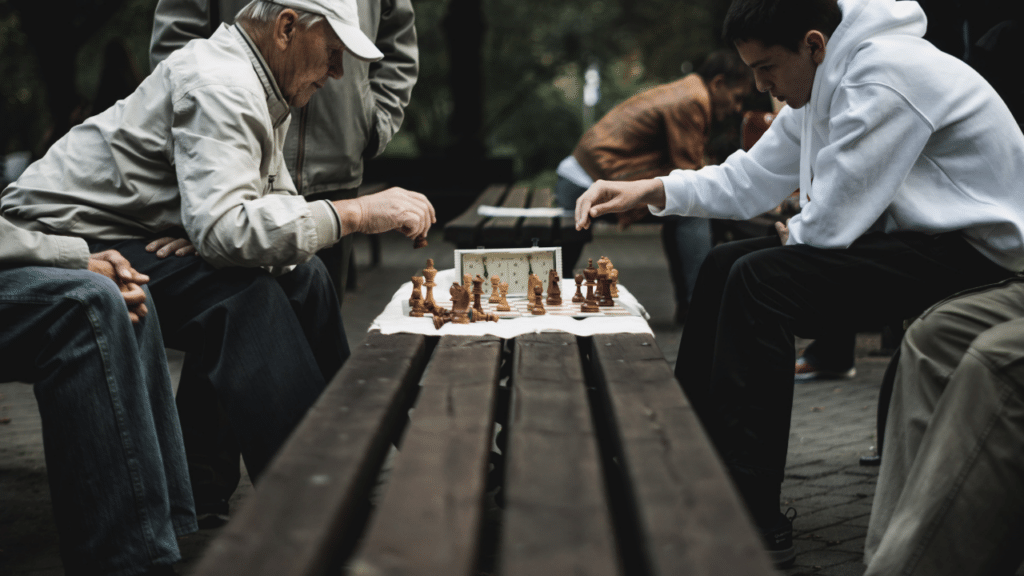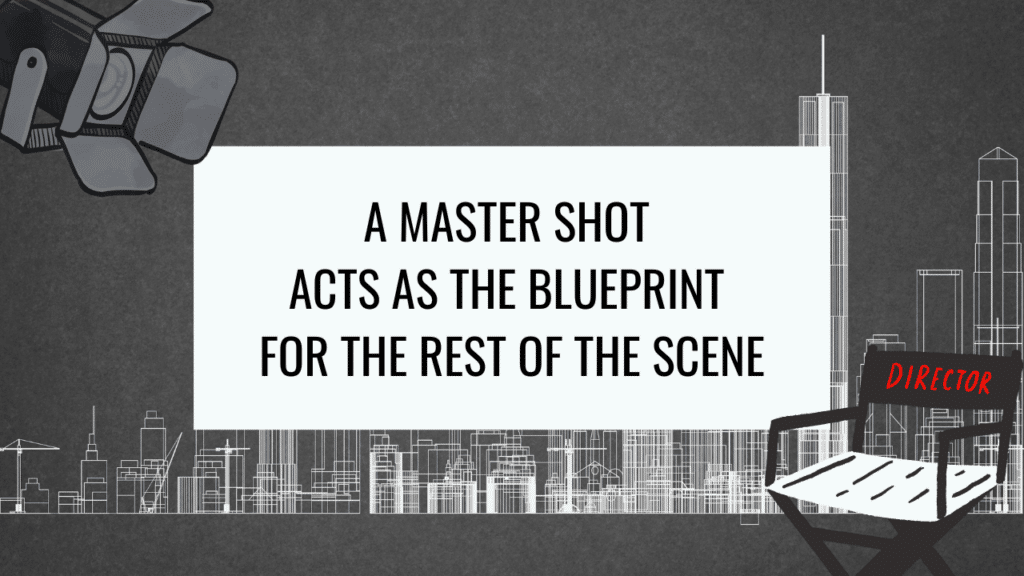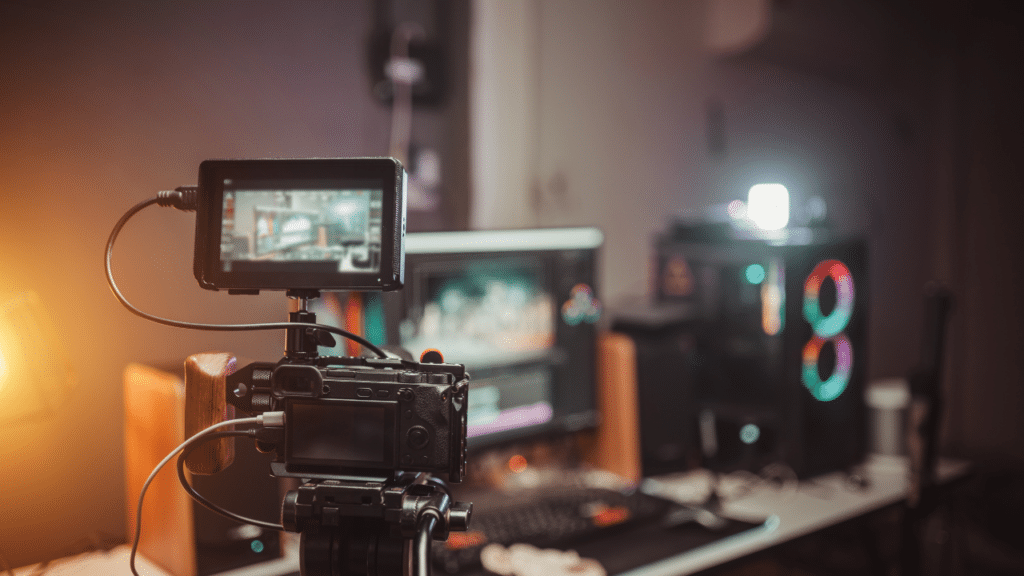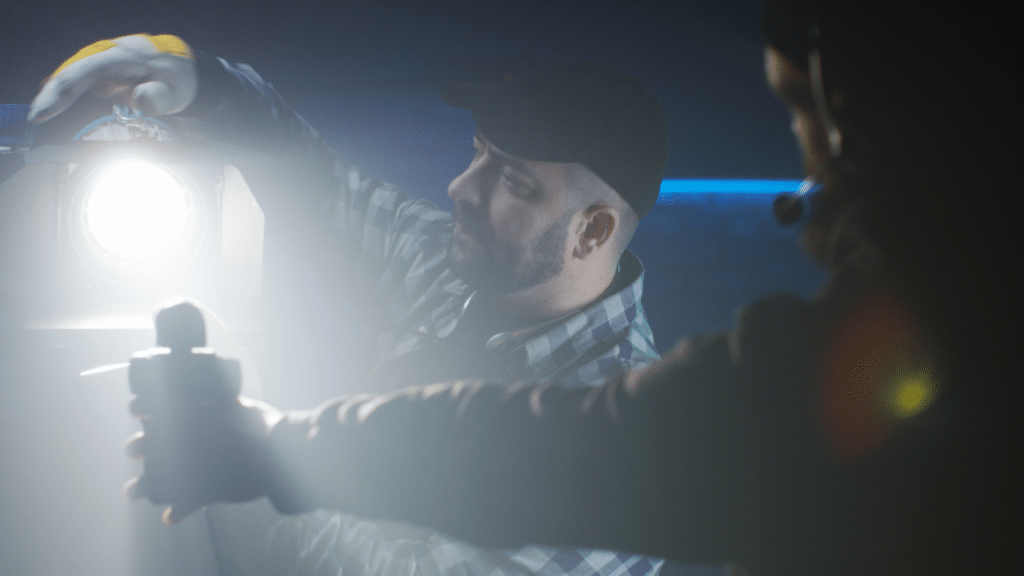Use the Master Shot to Your Advantage
Article by Colette Nichol, Solo Filmmaker and Story Strategist
Estimated reading time: 9 minutes
What is a master shot in filmmaking? In the simplest terms, a master shot is a long, continuous shot that captures the entire scene.
It’s the filmmaker’s blueprint for the scene, showing all the characters, their actions, and the setting.
Imagine that you’re filming a chess game. Your master shot would be a wide shot from the side where you shot the entire chess game from start to finish. To make the game more visually engaging, you’d also go in and get medium shots, close-ups, overhead shots, and maybe some extreme close-ups. You might also get some reaction shots from the crowd.
And maybe you’d also get some insert shots of the clock or the player’s standings.
You’d probably also want to spice up your mediums with over-the-shoulders shots. This combination of shots will allow you to cover the scene in a way that keeps your audience engaged.
Think of your master shot as an overview, where you can see the entire chessboard and every single move in a scene, not just individual moves.

What You Need from a Master Shot
A master shot should capture the essence of your scene.
It should tell your story, show the characters’ relationships, and frame the action in context. It’s like a storyboard come to life. It requires meticulous planning, from camera positioning to actor blocking. You need to make sure you capture all the action of the scene from start to finish.
The Origin of Master Shots
Master shots originated in early cinema when filmmakers had only one camera to capture the action.
It was a necessity that sparked creative visual storytelling techniques we still use today.
When Do You NOT Need a Master Shot?
You don’t always need a master shot.
Depending on the style of filmmaking you’re doing, a master shot may be necessary, irrelevant or impossible.
With documentary filmmaking, you can’t shoot a master shot because you’re not filming actors; you’re filming real life, which only happens once.
Filmmakers might choose to shoot a scene using an overlap technique (+), multiple cameras, or a series of one-shots. Remember, filmmaking is about storytelling.
Decide how you’re going to film a scene based on the story and the style of your film.
But don’t forget that your editor needs enough footage to be able to cut a scene that feels continuous.
Master Shots vs Wide Shot vs Establishing Shots
Often confused, master shots and wide shots aren’t interchangeable.
A wide shot can be a master shot, but not always.
Wide shots establish location and context. A wide shot is just a shot with a wide angle of view. Meanwhile, a master shot refers to a shot that is wide enough in terms of angle of view to capture the entire scene from start to finish. The master shot lays out the scene’s action. If you’re shooting coverage, your master shot is the main shot you use to connect all the other medium shots and close-ups.
An establishing shot is used at the start of a scene to establish the location.
If you’re transitioning from a scene at somebody’s dining table to a scene at a diner, you might cut from the dining table to the exterior of the diner (your establishing shot), then cut to a medium-wide shot of your two characters at the diner.
You might have a wide shot that isn’t necessarily used as an establishing shot. For example, think of a scene where group of characters are climbing a mountain. As they reach the peak, the shots are all mediums and close ups. We’re focusing on their emotions and the pain of the struggle.
They make it to the peak! Huzzah!
We might cut to close-ups of the character’s faces to experience the intensity of the emotion. And then we might pull back or cut to a massive areal shot which shows the insane mountain range and the heights that they’ve reached. In this case, the wide shot is used at the end of a scene to create a dramatic full-circle moment. It’s a wide shot. But it’s not an establishing shot.
📽️ Related Post : Filming Techniques for Capturing (Absolutely) Anything
What Does A Master Shot Do?
A master shot acts as the blueprint for the rest of the scene.
It’s used in the edit as the guide or reference point. It directs the scene’s pace and sets the visual rhythm. It’s a reference point, helping you ensure continuity when cutting.

Does Your Master Shot Have to Be Static?
Your master shot can be a still frame, or it can be moving.
You can follow the action with your master shot or use key camera movements. Or you can choose a frame and shoot your master without any added camera moves.
If you’re adding camera movement to your master, your shooting time is going to be longer than if you shoot your master on sticks (i.e. on a tripod).
If you’re doing something more kinetic, you may choose to shoot your master shot with your camera on a handheld rig or gimbal to allow a more kinetic feel but without introducing camera movements.
Remember that if you’re moving your camera closer or further away from the talent or you’re following the talent, you either need to have a focus puller or you need a camera with incredible auto-follow focus.
Otherwise, your talent will move in and out of focus, and your shot will be ruined. Depending on how much depth of field you have, there may be some wiggle room
📽️ Related Post: How to Learn Filmmaking? Start with the Fundamentals

How to Create the Best Possible Master Shots
Crafting the perfect master shot isn’t easy. It requires a clear vision, careful planning, and precise execution.
It’s about understanding the scene’s dynamic and how best to capture it.
- Assess the scene you’re shooting so you’re clear on the story and action.
- Block the action.
- Decide if you’re going to do a static master or a complex master with camera movement.
- Plan the framing of the master so it includes all the important actions and characters.
- Choose a frame for the master that is relatively neutral, i.e. not some weird low or high-angle shot.
- If you’re doing a complex master, plan the camera moves and take into account the shooting time and crew you’ll need to pull this off.
- Ensure that your lighting in the master will be replicable in the medium shots and close-ups. This is particularly important if you’re using natural light.
- Be aware of how any visual effects in the master shot will need to be replicated in the mediums and close-ups.
- Watch out for things like clocks, food and drink levels, or the weather in the master that need to be replicated in the mediums. Ideally, don’t include a clock in the master!
Examples of Master Shots in Film
Inglorious Basterds Master and Coverage Example
Identify the master shot and then the medium wides, mediums and close-ups.
This is a very theatrical style of filmmaking. It’s also something that you see in sitcoms. You can’t shoot a scene like this unless your script and dialogue are killer and your actors are brilliant.
As audience members, we won’t watch this style of film unless all the pieces are brilliant.
One of the reasons we see so many cuts in movies these days is because constant cutting and movement keep the audience’s attention with a sort of hypnosis. So your actual story doesn’t have to be as good. Not that I recommend you do that.
Rope Oner Example
In this case, the entire shot is a master shot, also known as a oner or one shot. A oner is when you shoot an entire scene in one shot.
Wolf of Wall Street Lambo Long Take
Scorsese is well known for his captivating one shots. You can only do something like this oner with great actors.
12 Best Long Takes
Matching Lighting and Blocking in the Medium Shots and Close Ups to the Master Shots
Master shots act as a roadmap for subsequent shots.
They guide the lighting and blocking for medium and close-up shots. Consistency is key to maintaining visual coherence and believability. Always refer back to your master shot when setting up subsequent shots. You can move the lighting in closer and fudge things a little, but it needs to be cohesive enough not to distract the audience from the story.

What is Shooting Coverage?
Coverage is filming from different angles to cover the scene.
It provides editing options, allowing for better pacing and storytelling. Without sufficient coverage, you might end up with jarring cuts, disrupting the film’s flow. Think of it as an insurance policy for your scene.
Why do Filmmakers Shoot Master Shots?
Master shots provide a complete view of the scene, aiding the storytelling process.
They set the scene, guide the viewer’s gaze, and ensure continuity. Depending on your shooting style, the master shot for each scene may be the backbone of your film, providing a solid structure to build upon.
More Filmmaking Articles to Feed Your Brain:
Filmmaking Basics Every Beginner Needs to Know
Cinematic Lighting: Epic Film Lighting Guide for Beginners
iPhone Filmmaking Tips for Beginners
Best Camera for Beginners
Learn Filmmaking and Get the Gear Guide
If you’re interested in learning filmmaking, check out the Solo Filmmaking Mentorship Program I created for aspiring filmmakers and video creators. It usually goes live once per year. So I recommend getting the Story Envelope Filmmaking letter which comes out a couple of times per month. That way, you can get filmmaking tips for free and find out when the filmmaking course is going live again.
Also, before you go, grab the Solo Filmmaking Gear Guide and Checklist for Beginners >>>

About the Author
Hi! I’m Colette Nichol. I’m a solo filmmaker and story strategist based out of rainy Vancouver, Canada. I’ve been making videos and micro films for small businesses and global brands since 2014.
Plus, I LOVE to help aspiring filmmakers pursue their dreams and start making films. This blog is designed to help you gain the knowledge you need to become a filmmaker.
If you want more, get on the waitlist for the Story Envelope Academy Solo Filmmaking Mentorship Program. It opens up one time per year and is the best way to become a filmmaking or video pro fast!
CLICK HERE to get on the solo filmmaking mentorship waitlist.